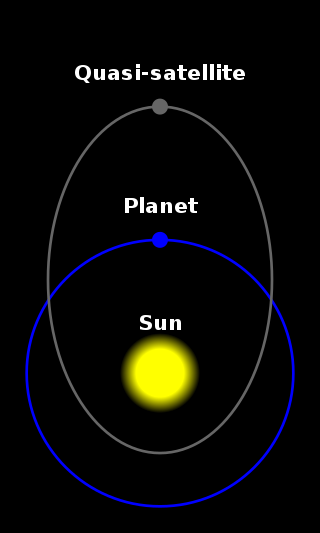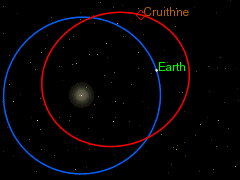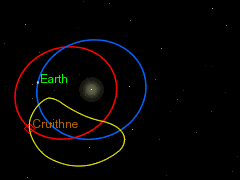
2002 AA29 (also written 2002 AA29) is a small near-Earth asteroid that was discovered on January 9, 2002 by the LINEAR (Lincoln Near Earth Asteroid Research) automatic sky survey. The diameter of the asteroid is only about 20–100 metres (70–300 ft). It revolves about the Sun on an almost circular orbit very similar to that of the Earth. This lies for the most part inside the Earth's orbit, which it crosses near the asteroid's furthest point from the Sun, the aphelion. Because of this orbit, the asteroid is classified as Aten type, named after the asteroid 2062 Aten.
2003 YN107 is a tiny asteroid, classified as a near-Earth object of the Aten group moving in a 1:1 mean-motion resonance with Earth. Because of that, it is in a co-orbital configuration relative to Earth.

A quasi-satellite is an object in a specific type of co-orbital configuration with a planet where the object stays close to that planet over many orbital periods.

5261 Eureka is the first Mars trojan discovered. It was discovered by David H. Levy and Henry Holt at Palomar Observatory on 20 June 1990. It trails Mars (at the L5 point) at a distance varying by only 0.3 AU during each revolution (with a secular trend superimposed, changing the distance from 1.5–1.8 AU around 1850 to 1.3–1.6 AU around 2400). Minimum distances from Earth, Venus, and Jupiter, are 0.5, 0.8, and 3.5 AU, respectively.

In celestial mechanics, a horseshoe orbit is a type of co-orbital motion of a small orbiting body relative to a larger orbiting body. The osculating (instantaneous) orbital period of the smaller body remains very near that of the larger body, and if its orbit is a little more eccentric than that of the larger body, during every period it appears to trace an ellipse around a point on the larger object's orbit. However, the loop is not closed but drifts forward or backward so that the point it circles will appear to move smoothly along the larger body's orbit over a long period of time. When the object approaches the larger body closely at either end of its trajectory, its apparent direction changes. Over an entire cycle the center traces the outline of a horseshoe, with the larger body between the 'horns'.

524522 Zoozve (provisional designation 2002 VE68) is a sub-kilometer sized asteroid and temporary quasi-satellite of Venus. Discovered in 2002, it was the first such object to be discovered around a major planet in the Solar System. It has nearly the same orbital period around the Sun that Venus does. In a frame of reference rotating with Venus, it appears to travel around it during one Venerean year, but it orbits the Sun, not Venus.
In astronomy, a co-orbital configuration is a configuration of two or more astronomical objects orbiting at the same, or very similar, distance from their primary; i.e., they are in a 1:1 mean-motion resonance..
2006 RH120 is a tiny near-Earth asteroid and fast rotator with a diameter of approximately 2–3 meters that ordinarily orbits the Sun but makes close approaches to the Earth–Moon system around every twenty years, when it can temporarily enter Earth orbit through temporary satellite capture (TSC). Most recently, it was in Earth orbit from July 2006 to July 2007, during which time it was never more than 0.0116 AU (1.74 million km) from Earth. As a consequence of its temporary orbit around the Earth, it is currently the second smallest asteroid in the Solar System with a well-known orbit, after 2021 GM1. Until given a minor planet designation on 18 February 2008, the object was known as 6R10DB9, an internal identification number assigned by the Catalina Sky Survey.

An Earth trojan is an asteroid that orbits the Sun in the vicinity of the Earth–Sun Lagrangian points L4 (leading 60°) or L5 (trailing 60°), thus having an orbit similar to Earth's. Only two Earth trojans have so far been discovered. The name "trojan" was first used in 1906 for the Jupiter trojans, the asteroids that were observed near the Lagrangian points of Jupiter's orbit.

(419624) 2010 SO16 is a sub-kilometer asteroid in a co-orbital configuration with Earth, classified as near-Earth object and potentially hazardous asteroid of the Apollo group. It was discovered by the Wide-field Infrared Survey Explorer space telescope (WISE) on 17 September 2010.
2013 BS45 (also written 2013 BS45) is a horseshoe companion to the Earth like 3753 Cruithne. Like Cruithne, it does not orbit the Earth in the normal sense and at times it is on the other side of the Sun, yet it still periodically comes nearer to the Earth in sort of halo orbit before again drifting away. While not a traditional natural satellite, it does not quite have normal heliocentric orbit either and these are sometimes called quasi-satellties or horseshoe orbits.
2001 GO2 is a very small asteroid and near-Earth object of the Apollo group, approximately 50 meters (160 feet) in diameter. Like 2003 YN107, it is in a co-orbital configuration relative to Earth moving in a 1:1 mean-motion resonance. It was first observed on 13 April 2001, by astronomers with the LINEAR program at the Lincoln Lab's ETS near Socorro, New Mexico, in the United States. 2001 GO2 has not been observed since its short four-day observation period in April 2001.
2015 SO2 (also written 2015 SO2) is an Aten asteroid that is a temporary horseshoe companion to the Earth, the ninth known Earth horseshoe librator. Prior to its most recent close encounter with our planet (2015 September 30) it was an Apollo asteroid.
2015 XX169 (also written 2015 XX169) is an Apollo asteroid that is a temporary horseshoe companion to the Earth, the tenth known Earth horseshoe librator. A close encounter with the Earth on 14 December 2015 caused the value of the semi-major axis of 2015 XX169 to drift slowly upwards, and the object evolved from an Aten asteroid to an Apollo asteroid about a year after this close approach.
2015 YQ1 (also written 2015 YQ1) is an Apollo asteroid that is a temporary horseshoe companion to the Earth, the twelfth known Earth horseshoe librator. It experienced a close encounter with the Earth on 2015 December 22 at 0.0037 AU.
2015 YA is a sub-kilometer asteroid, classified as near-Earth object of the Aten group, that is a temporary horseshoe companion to the Earth. It is the 11th known Earth horseshoe librator. Prior to a close encounter with the Earth on 15 December 2015, 2015 YA was an Apollo asteroid.
Kimmo Albin Innanen was a Canadian astrophysicist of Finnish descent.

469219 Kamoʻoalewa, provisionally designated 2016 HO3, is a very small asteroid, fast rotator and near-Earth object of the Apollo group, approximately 40–100 meters (130–330 feet) in diameter. At present it is a quasi-satellite of Earth, and currently the second-smallest, closest, and most stable known such quasi-satellite (after 2023 FW13). The asteroid was discovered by Pan-STARRS at Haleakala Observatory on 27 April 2016. It was named Kamoʻoalewa, a Hawaiian word that refers to an oscillating celestial object. The Earth-like orbit and lunar-like silicates may be a result of it being lunar ejecta.
2020 PN1 is a sub-kilometer asteroid, classified as a near-Earth object of the Aten group, that is a temporary horseshoe companion to the Earth. There are dozens of known Earth horseshoe librators, some of which switch periodically between the quasi-satellite and the horseshoe co-orbital states.
2020 PP1 is a sub-kilometer asteroid, classified as a near-Earth object of the Apollo group, that is a temporary quasi-satellite of the Earth. There are over a dozen known Earth quasi-satellites, some of which switch periodically between the quasi-satellite and horseshoe co-orbital states.














